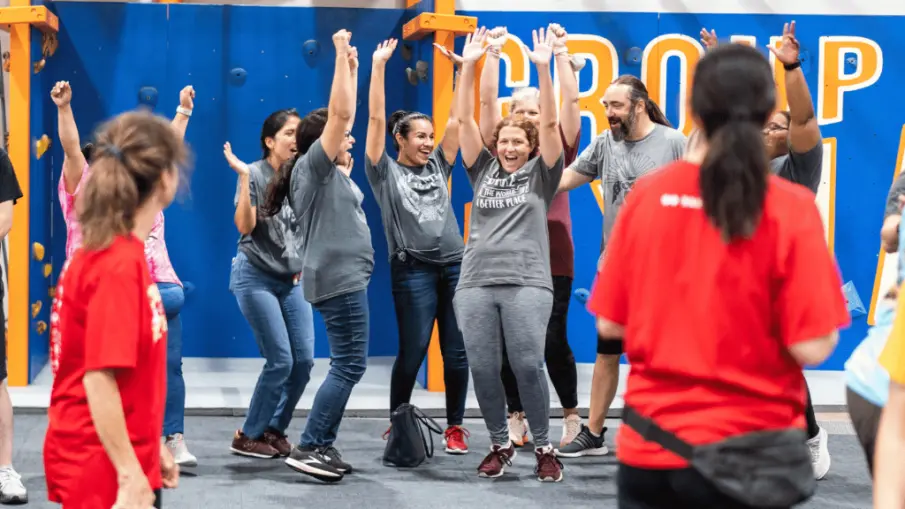Building Trust and Collaboration: Unique Group Activities That Drive Success

How do you transform a group of individuals into a powerhouse team? The answer lies in unique group activities that go beyond the typical trust falls and icebreakers.
Imagine activities that challenge your team to think differently, communicate more effectively, and trust each other implicitly. These aren't your run-of-the-mill team-building exercises; they're carefully crafted experiences designed to break down barriers and build lasting connections. From role-reversal exercises that boost empathy to problem-solving challenges that sharpen communication skills, we're about to dive into a world of innovative group activities that drive real results.
In this article, I'll guide you through a series of engaging and sometimes surprising activities that have been proven to foster trust, enhance collaboration, and, ultimately, propel teams toward success. Whether you're a team leader looking to energize your group or a member seeking ways to contribute to a more cohesive work environment, you're in for an eye-opening journey. Get ready to discover how these unique group activities can transform your team dynamics and set the stage for unprecedented success.
The Importance of Trust and Collaboration in Team Success
The impact of collaboration on team performance is staggering. According to recent studies, companies that promote collaborative working are five times more likely to perform at a high level. This statistic underscores the immense value of fostering a collaborative culture within organizations. When team members trust each other and work together seamlessly, they're able to tackle complex challenges more effectively and innovate at a faster pace.
But collaboration doesn't just happen on its own. It needs to be nurtured and developed through intentional efforts. This is where team-building exercises come into play. These activities serve as catalysts for building trust, improving communication, and enhancing overall team dynamics. Interestingly, research shows that 50% of positive changes in communication patterns can be attributed to socializing as a team. This highlights the importance of creating opportunities for team members to interact outside of their usual work context.
Trust, in particular, is the glue that holds collaborative efforts together. When team members trust each other, they're more likely to share ideas openly, take calculated risks, and support one another through challenges. This trust creates a psychological safety net that encourages creativity and innovation, allowing teams to push boundaries and achieve exceptional results.
Moreover, strong collaboration and trust lead to improved problem-solving capabilities. Teams that work well together can leverage diverse perspectives and skill sets to approach issues from multiple angles. This collective intelligence often results in more robust and innovative solutions than what individuals could achieve on their own.
In essence, trust and collaboration are not just nice-to-have qualities in a team; they're essential drivers of success. By investing in team-building exercises and fostering a culture of trust and collaboration, organizations can unlock their teams' full potential and gain a significant competitive edge.
Group Activities That Foster Trust
Not all activities are created equal when it comes to building trust within a team. The most effective team-building activities go beyond simple icebreakers to create meaningful experiences that challenge and unite team members. Let's explore some unique and powerful group activities that can significantly boost trust and collaboration.
Role-Reversal Exercises for Empathy Building
One of the most impactful activities for group bonding involves role-reversal exercises. These activities challenge team members to step into each other's shoes, fostering empathy and understanding. For example, a "Day in the Life" exercise where team members swap roles for a day can be eye-opening. This experience helps individuals appreciate the challenges and responsibilities of their colleagues, leading to increased mutual respect and trust.
Another effective role-reversal activity is the "Perspective Carousel." In this exercise, team members rotate through different perspectives on a work-related issue, arguing from various stakeholder viewpoints. This not only builds empathy but also enhances problem-solving skills by encouraging diverse thinking.
Problem-Solving Challenges for Better Communication
Problem-solving challenges are excellent team-building activities for groups that want to improve their communication and collaboration skills. These activities often involve complex puzzles or scenarios that require the entire team's input to solve.
Research shows that participants primed to act collaboratively worked on a challenging puzzle for 64% longer than control groups. This demonstrates the power of collaborative problem-solving in increasing persistence and engagement. Activities like "Escape Room" challenges or "Bridge Building" exercises where teams must construct a bridge using limited materials can be particularly effective.
These problem-solving activities force team members to communicate clearly, listen actively, and work together towards a common goal. As they overcome challenges together, trust naturally builds, and team members learn to rely on each other's strengths.
Adventure-Based Learning to Break Down Barriers
Adventure-based learning takes team building to a whole new level. These activities often involve outdoor challenges or physical tasks that push team members out of their comfort zones. Examples include ropes courses, wilderness survival exercises, or even urban scavenger hunts.
The beauty of adventure-based learning lies in its ability to break down hierarchical barriers and create a level playing field. When faced with a physical challenge, titles and office politics fade away, leaving room for authentic interactions and support.
Team-building activities can improve psychological safety, leading to a climate where people are comfortable being and expressing themselves. Adventure-based learning exemplifies this by creating shared experiences that bond team members through mutual support and achievement.
For instance, a "Trust Fall" exercise, where team members catch a falling colleague, physically demonstrates the concept of trust. Similarly, a "Blind Hike," where sighted team members guide blindfolded colleagues through a trail, builds trust through reliance on clear communication and guidance.
These unique group activities go beyond traditional team-building exercises. They create lasting impacts by fostering empathy, improving communication, and breaking down barriers. By engaging in these experiences, teams can build a foundation of trust that translates directly into improved collaboration and performance in the workplace.
Enhancing Team Performance Through Experiential Learning
Experiential learning is a powerful tool for enhancing team performance, and it's at the heart of effective group team-building activities. This approach goes beyond traditional classroom-style training, immersing team members in hands-on experiences that drive home key lessons about collaboration, communication, and trust.
One of the most compelling aspects of experiential learning is its ability to create lasting change. When team members actively participate in a fun team-building event, they're not just passively absorbing information—they're living it. This visceral experience makes the lessons stick, leading to real behavioral changes back in the workplace.
Consider this striking statistic: When employees feel their opinions matter, there is a 27% drop in employee turnover, a 40% drop in safety incidents, and a 12% boost in productivity. Experiential learning activities are designed to foster exactly this kind of inclusive environment, where every team member's input is valued and heard.
For instance, a problem-solving challenge like "Lost at Sea" requires teams to prioritize items for survival on a deserted island. This activity encourages open discussion, critical thinking, and consensus-building – all skills that translate directly to improved workplace performance. As team members debate and decide together, they're practicing the art of valuing each other's opinions in a low-stakes, engaging setting.
Another effective experiential learning activity is the "Blind Square" exercise. In this task, blindfolded team members must work together to form a perfect square with a rope. This activity hones communication skills, builds trust, and emphasizes the importance of clear, concise instructions – all crucial elements for enhancing team performance in the workplace.
Role-playing scenarios are also powerful tools in the experiential learning toolkit. By acting out challenging workplace situations in a safe, controlled environment, team members can practice new communication strategies and problem-solving techniques. This rehearsal helps them feel more confident and prepared when similar situations arise in their actual work.
The beauty of experiential learning lies in its versatility. Whether you're organizing an outdoor adventure course or a series of indoor team challenges, the key is to create experiences that push team members out of their comfort zones and into a space of growth and discovery. These shared experiences bond team members, creating a sense of camaraderie that carries over into their daily work interactions.
Moreover, experiential learning activities can be tailored to address specific team challenges or goals. If a team struggles with decision-making, activities that require quick, collaborative choices under pressure can be introduced. If communication is an issue, exercises that rely heavily on clear, effective communication can be emphasized.
By incorporating experiential learning into your team-building strategy, you're not just organizing a fun team-building event—you're investing in your team's long-term success. These activities create a foundation of trust, improve communication, and foster a sense of shared purpose that can dramatically enhance team performance. The lessons learned through these hands-on experiences stick with team members long after the event is over, continually influencing their interactions and decision-making in positive ways.
How Hands-On Activities Reinforce Skills
Hands-on activities are not just fun for adults; they're powerful tools for reinforcing crucial workplace skills. When we engage in activities for groups of adults that require active participation, we're doing more than just having a good time—we're creating lasting neural pathways that enhance our professional capabilities.
Collaborative activities can increase engagement and success rates while reducing fatigue. This insight underscores the value of incorporating hands-on, group-based activities into our professional development strategies. By engaging in these activities, team members not only learn new skills but also reinforce existing ones in a low-pressure, high-engagement environment.
Let's explore some specific ways that hands-on activities can reinforce essential workplace skills:
- Communication Skills: Fun activities for a group, such as a "Silent Line-Up" where team members must arrange themselves in order without speaking, force participants to find creative ways to communicate. This exercise strengthens non-verbal communication skills, which are crucial in many workplace scenarios.
- Problem-Solving Abilities: Adult group activities like escape rooms or puzzle-solving challenges require teams to think critically and work together to find solutions. These experiences translate directly to improved problem-solving skills in the workplace.
- Leadership Development: Activities for groups of adults that involve rotating leadership roles, such as "Blind Leader," where one team member must guide blindfolded colleagues through an obstacle course to help develop and reinforce leadership skills in a practical, experiential way.
- Adaptability: Fun activities for adults that involve unexpected twists or changing rules, like "Flip the Tarp," where teams must turn over a tarp they're standing on without stepping off, reinforce adaptability – a crucial skill in fast-paced work environments.
- Teamwork and Collaboration: Almost all activities for group settings reinforce teamwork, but some, like "Human Knot," require team members to untangle themselves without breaking hand contact, specifically targeting collaborative problem-solving skills.
By incorporating a variety of hands-on activities into your team's routine, you're not just providing fun diversions – you're actively reinforcing critical workplace skills. These experiences create a shared language and reference points for teams, making it easier to apply learned skills in real work situations. Whether it's improving communication, enhancing problem-solving abilities, or fostering better collaboration, hands-on activities offer a dynamic and effective way to reinforce the skills that drive success.
Conclusion
Throughout this article, we've explored how unique group activities are powerful tools for driving success in the workplace. They build trust, enhance collaboration, and reinforce essential skills. Investing in these experiences fosters an environment where trust flourishes, communication flows freely, and team members feel valued and heard. These hands-on activities create lasting impacts on team dynamics and individual performance by making lessons stick in ways that traditional training methods often fail to achieve. The most effective team-building strategies incorporate a mix of activities that challenge team members to step out of their comfort zones, think creatively, and work together towards common goals. By embracing these unique group activities, you're not just building a team – you're creating a resilient, high-performing unit ready to tackle any challenge that comes its way.
Robert Warner Author Bio
Robert Warner’s journey from New York to Dallas, with stops in Nashville and Iowa, led him to earn a Master’s in Counseling and raise three wonderful kids. For over 22 years, Robert has thrived at Group Dynamix, where he turned a part-time opportunity into a career dedicated to fostering connection through fun, meaningful experiences.
With roles spanning Event Leader, Marketing, HR, and now General Manager, Robert passionately leads Group Dynamix’s mission to help people feel connected, valued, and part of a team. He enjoys sharing insights on resolving conflict, the power of community, and finding purpose in both life and work.
More to Read:
Previous Posts:








